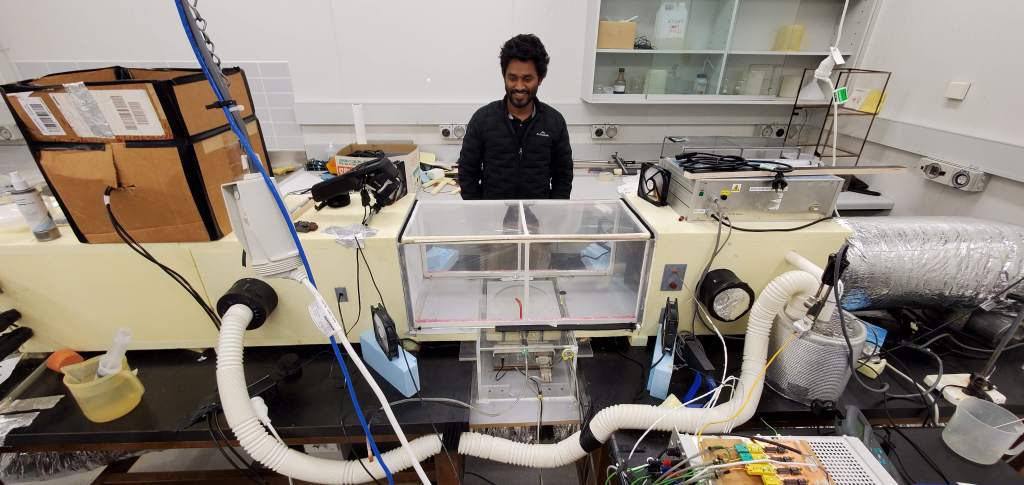
Climate & Fluid Physics Laboratory
Facilities
Take yourself on a 360o virtual tour of the Climate & Fluid Physics Laboratory, as well as other research facilities at The Australian National University.
The Large Rotating Annulus (LRA) is one of two precision rotating tables in the Climate & Fluid Physics Laboratory. The LRA has an outer diameter of 1.6m and depth of 40cm, and is capable of maintaining rotation rates of up to 4 radians per second. It has an outer jacket that can be held at an independent constant temperature so as to impose a sidewall boundary condition. The inner section is modular and can also be maintained at an independent constant temperature. In this base configuration of a rotating annulus with an imposed sidewall temperature difference, the LRA is the world’s largest Hide Tank, after the canonical experiments of Raymond Hide (Hide, 1958).
Additional capabilities include a differentially-rotating ring that is able to translate objects, such as bottom topography, around the annulus at precisely controlled rates, thereby imposing a relative velocity between the fluid and topographic feature. A full size radially-sloping false base is also available to enhance the radial gradient of fluid depth and incorporate beta-effects into the system.
The LRA is instrumented with onboard optical and thermal cameras to observe the fluid flow, and an array of translating profiling thermistors to measure the internal thermal structure and dynamics within the system.


The Sea Ice Facility is a thermally-isolated apparatus used to grow and analyse sea ice in idealised and controllable conditions. It consists of an “atmosphere” region in which air is maintained at sub-zero temperatures and blown by fans to impose a relative “wind”, an “ocean” region in which actual seawater is maintained at -2oC, and a “sea ice” region situated between these two in which an array of thermocouples measure temperature and polarised light is used to observe sea ice structure. As the ocean loses heat to the atmosphere above, sea ice begins to form at the interface and grow downwards into the ocean, occupying the sea ice region. This configuration allows for the measurement of sea ice thermal structure and associated properties, such as thermal conductivity.

The Precision Wind Tunnel is recirculating duct with complete environmental control of air temperature (+/-0.1oC), humidity (+/-1%) and wind-speed (+/- 0.05 m/s). The window section is made from material that is transparent to both shortwave and longwave radiation, allowing radiative forcing to be imposed. This apparatus is currently being used to directly measure the effect of the increased longwave radiation associated with a warming climate on the evaporation rate of water. Evaporation rates are measured by a precision balance integrated into the base of the tunnel.

The Ice-Ocean Interaction Apparatus is a 1.2m deep by 1.5m long double-glazed tank housed in the controllable temperature isolation laboratory. The tank incorporates a vertically-oriented heat exchanger into one sidewall. The tank is initially filled with freshwater, and sub-zero temperature fluid is pumped through the vertical heat exchanger, causing fresh ice to form and grow full-depth against the sidewall. When a sufficiently thick (~15cm) slab of fresh ice has grown, the ambient freshwater is replaced with salty water with prescribed thermodynamic properties (e.g., temperature, salinity, stratification) or imposed dynamics (e.g., internal waves). The melting dynamics of the fresh ice are able to be observed in time and characterised by the imposed oceanic conditions.

The Long Internal Wave Tank is a 5.25m long and 20cm wide glass tank designed to investigate internal wave dynamics in stratified fluids. It incorporates a modular central section which is able to accommodate width-constrictions so as to accelerate exchanges and trigger instabilities, as well as a computer-controlled cable system able to tow objects across the tank surface at prescribed velocities.


The Climate & Fluid Physics Laboratory maintains a wide range of teaching and demonstration apparatus, including recirculating open channels, numerous gravity current tanks, internal wave apparatus, dense overflow tank for depicting Kelvin-Helmholtz instabilities, and a second precision rotating table.



